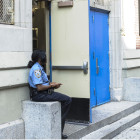
The majority of American youth behind bars have suffered trauma during their childhoods, a newly released report by the Justice Policy Institute (JPI) says. According to Healing Invisible Wounds: Why Investing in Trauma-Informed Care for Children Makes Sense, of the more than 93,000 children currently incarcerated, between 75 and 93 percent have experienced at least one traumatic experience, including sexual abuse, war, community violence, neglect and maltreatment. “Incarcerated youth already face significant challenges, but youth who have experienced trauma are even more acutely affected,” says author Dr. Erica Adams. The brief, published by the Washington, D.C.-based organization that promotes the reduction of the nation’s prison population, notes that youth who engage in delinquent behavior should be held accountable but also strongly suggests that judges consider trauma exposure when deciding where youth are placed. Young people who receive treatment in the community tend to have better outcomes than those placed in correctional facilities, the report says. “We simply cannot afford to ignore the evidence and prevalence of the long-term effects of untreated childhood trauma,” says JPI Executive Director Tracy Velázquez.





